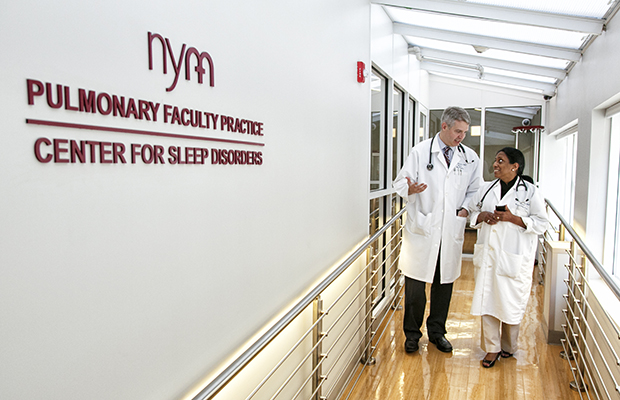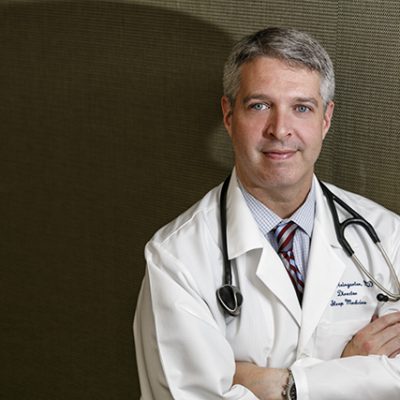
Sleep Experts at New York Methodist Hospital in Brooklyn Focus on accurate diagnosis as the key to sweet dreams for patients
By Megan Schade Photos • By Amesse Photography
Sleep. So simple, yet so very, very complicated. Every 24 hours, we must dance with sleep; for some, it is a fickle partner who teases yet remains elusive; others can slow dance for hours, wrapped in the arms of Morpheus.
“Difficulty falling asleep, staying asleep, waking up repeatedly throughout the night—there are so many different types of sleep disorders, and an even greater number of possible underlying causes,” said Jeremy Weingarten, M.D., director of the Center for Sleep Disorders and the Pulmonary Physiology Laboratory at New York Methodist Hospital.
“In an average life span, a person will spend about 25 years asleep—over a quarter of their lives,” continued Dr. Weingarten. “Yet that one quarter can significantly impact the remaining time, not only behaviorally, but physically as well. We all know how it feels to have a rough night’s sleep: we wake up cranky, sleepy, irritable. Now imagine what your life would be like if you slept like that every night. Cognitively, sleep deprivation can lead to mood disorders, memory loss, delayed reaction time, and inability to concentrate, among other conditions. Physically, fluctuations in oxygen saturation, as seen with obstructive sleep apnea, wreak havoc with the cardiovascular system, increasing the risk of heart attack and stroke.”
New York Methodist Hospital is home to the Center for Sleep Disorders, the only hospital-based sleep center in Brooklyn to receive accreditation from the American Academy of Sleep Medicine. “Accurate diagnosis is the single most important key to overcoming a sleep disorder,” said Dr. Weingarten. “Testing in the sleep lab at the Center can determine the origin of the disorder—physical or psychological—and treatment can be tailored, based on that determination.”
The center is newly renovated, providing eight private bedrooms (some with private baths) and special rooms for pediatric and bariatric patients. The center also provides special accommodation for pediatric patients. “We have adjoining rooms so that a parent can sleep in a bed near their child. We also have lab technicians who are specially trained to work with children undergoing sleep evaluations,” said John Cunningham, chief technologist at the Center for Sleep Disorders.
“A typical sleep study in our Center begins at 8:00 p.m. and ends at 7:00 a.m. on the following day,” said Cunningham. “During a sleep study, we use both optical and infrared cameras, sophisticated computer software, and devices that allow us to monitor a patient’s eye movement, breathing, leg movements, lung function, cardiac function, and other vital processes. We want our physicians and sleep experts to have all the information they need to evaluate a patient’s health during sleep. We’re not testing for one sleep disorder—we’re testing for all of them, in one night.”
“Although there are many types of sleep disorders, including narcolepsy, restless legs syndrome/periodic limb movement disorder, parasomnias (sleepwalking, night terrors), obstructive sleep apnea is by far the most common seen in our center,” Dr. Weingarten said. Sleep apnea is a momentary cessation of breathing during sleep: the pauses in breathing can last anywhere from a few seconds to a few minutes, and often occur hundreds of time a night. Obstructive sleep apnea occurs when the airway becomes blocked and the diaphragm must push extra hard to force air in and out, producing the loud snores that can accompany this disorder. Such blockage from a collapsed airway is most common in overweight adults, but pediatric obstructive sleep apnea can also result from conditions such as swollen tonsils.
“Should sleep apnea be diagnosed, by far the most common and effective treatment is CPAP (continuous positive airway pressure),” the doctor added. “CPAP provides air pressure through the throat to prevent the airway from collapsing, thus preventing multiple awakenings and fostering a better, and actually restorative, night’s sleep.”
Dr. Weingarten knew early in his medical career that he wanted to specialize in pulmonology and pulmonary physiology. (In addition to his role as head of the Sleep Disorders Center, he also currently serves as acting chief of the Division of Pulmonary, Critical Care, and Sleep Medicine.) “Honestly, I thought lungs were really interesting, and proper lung function—or the lack of it— was at the foundation of everything we were studying,” he said. Dr. Weingarten went to medical school at SUNY Stony Brook and did his residency at the University of Pittsburgh. He went on to complete several fellowships: one in pulmonary transplant medicine at the University of Pittsburgh as well as a second one in pulmonary, critical care, and sleep medicine at Columbia University. A life-long learner, Dr. Weingarten is currently working on a master’s degree in epidemiology at Columbia University’s Mailman School of Public Health.
While lungs and breathing are at the foundation of sleep, not all sleep disorders are respiratory in origin. “There are many psychological components to sleep,” said Boris Dubrovsky, Ph.D., associate director of the Center, and clinical psychologist board-certified in behavioral sleep medicine. “Poor sleep can trigger psychological events, and vice versa; sleep and behavior have a very symbiotic relationship. To that end, the center has expanded its services to include behavioral sleep medicine. Studies have shown that cognitive behavioral therapy, which aims to identify triggers and change behavior, is often just as beneficial as medication in combating insomnia.
“Parents will be happy to know we have expanded our program to include what is known as behavioral insomnia of childhood. A child’s sleep patterns, or absence of them, can wreak havoc on a family. Our program works with parents to help establish healthy sleep routines and habits, and introduce proper sleep hygiene to bedtime.”
Another condition treated at the Center is circadian rhythm disorder.
“These are often very distressing to patients and families,” said Dr. Liziamma George, a pulmonologist, sleep physician, and member of the Center’s team. “Our circadian rhythm is our body’s internal clock, and runs on a roughly 24-hour cycle. This clock controls many of the body’s processes—including sleep. People with a circadian rhythm disorder find that their body’s desire to sleep is incompatible with ‘society’s hours—either they need to begin sleep too early in the day and consequently rise too early, or the other way around,” George explained. “Other problems, such as shift work sleep disorder and jet lag are also considered circadian rhythm abnormalities. Treatment includes sleep timing, melatonin administration, and bright light therapy, which involves focusing a strong light on an individual either before bedtime or after awakening. All of these measures help to gently nudge the internal clock towards a more functional schedule.”
“Sleep doesn’t have to be a struggle,” said Dr. Weingar ten. “One of the most rewarding aspects of my job is to treat patients with a sleep disorder—and then see them at the follow-up appointment looking like new people. So often I hear them say, ‘I had no idea I could feel so good.’” •
Center for Sleep Disorders
at New York Methodist Hospital
New York Methodist Hospital / 506 Sixth St., / 718.780.3017








